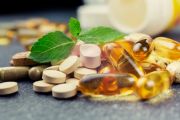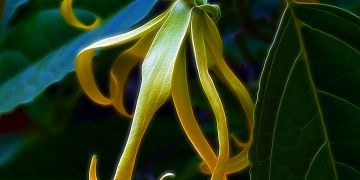Habitat
The cananga is a tropical tree that is native to the rainforests of Indonesia and the Philippines. Production of ylang ylang oil began in the Philippines around 1860, and today the supply of essential oil comes from cultivated trees.
Main Active Ingredients
According to a January 2013 study published in the journal Molecules, the ability to identify individual components of essential oils improved recently with use of two-dimensional gas chromatography along with time-of-flight mass spectrometry. When this advanced method was used to evaluate ylang ylang, the authors found 161 individual compounds, which was 75 more than identified using previous methods.
The main chemical components in ylang ylang oil include the following:
- Methyl benzoate - 34.00%
- 4-methylanisole - 19.82%
- Benzyl benzoate - 18.97%
- Isocaryophyllene - 9.28%
- Germacrene D - 8.15%
- Alpha-farnesene - 2.73%
- Linalyl acetate - 2.11%
- Alpha-caryophyllene - 2.04%
- Copaene - 1.65%
- Cadinene - 1.25%
Parts used
Ylang-Ylang oil is extracted from the flowers using a water or a water and steam distillation method. The essential oil has an aroma that has been described as fruity, pungent, sweet and flowery.
Health benefits
The health benefits associated with ylang ylang essential oil are related to the ability to reduce tension and anxiety which then leads to an improvement in blood pressure. Three studies that support these claims are presented here.
Study one
Twenty-four healthy individuals were exposed to ylang ylang or to an odorless placebo. The authors reported (Planta Medica) that compared with placebo, ylang ylang essential oil was associated with significant declines in pulse rate and blood pressure and with an increase in alertness and attentiveness.
Study two
Eighty-three people with prehypertension or hypertension were divided into three groups. Group 1 (28 patients) inhaled an essential oil combination composed of ylang ylang,lavender, marjoram and neroli for 24 hours. Group 2 (27) inhaled an artificial fragrance. Group 3 (28) had no fragrances. At the end of 24 hours of blood pressure monitoring, daytime systolic and diastolic blood pressures were significantly lower among subjects who inhaled essential oils when compared with individuals in the other two groups. Nighttime blood pressures were similar among all three groups. The essential oil group also had a significant decline in levels of salivary cortisol when compared with the other two groups. The authors concluded (Evidence Based Complementary and Alternative Medicine 2012) that “essential oils may have relaxation effects for controlling hypertension.”
Study three
Forty-two individuals with high blood pressure were assigned to a group in which they inhaled essential oils for 2 minutes twice a day for 3 weeks (22 participants) or to a control group (20). The combination of essential oils included ylang ylang, lemon and lavender while the control group inhaled an artificial citrus fragrance. In the essential oil group, systolic but not diastolic blood pressure improved, as did heart rate variability. This latter factor is associated with heart health, diabetes and other serious conditions. The authors concluded (Journal of Korean Academy of Nursing that “aromatherapy is effective in lowering systolic blood pressure” and heart rate variability.
Using ylang ylang
As with all essential oils, Ylang Ylang can be inhaled, added to bath water or applied to the skin if diluted with a carrier oil first.
Ylang ylang essential oil can cause headache or nausea if used in excess. Therefore, only use in small amounts.
Purchase ylang ylang essential oils that say “complete.” This means the oil was obtained via an uninterrupted distillation process. Products called ylang ylang extra, I, II or III are called fractions and contain less constituents.





